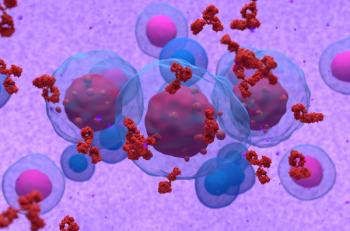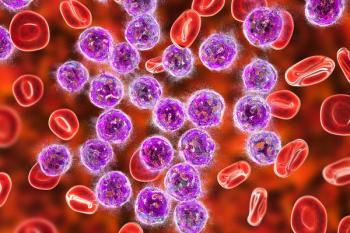
The True Meaning of a Hepatitis C Cure
New hepatitis C drugs moved the dream of a cure into a reality that gives patients a new chance at life.
“It’s not so much the fear of dying, it’s the fear of suffering.”
Alan Franciscus was terrified, he recalled, as he retraced the winding path that took him from a frightened patient suffering the effects of the hepatitis C virus (HCV) to a cured advocate guiding those now walking the same path he traversed years ago.
“I thought, ‘If I’m this tired and achy now, with my brain this foggy, what is it going to be like in five years or 10 years? Am I going to be able to take care of myself, be with my friends and family?’ You get very negative, and everything turns dark and depressing. It’s awful,” Franciscus said.
Following his HCV diagnosis in 1996, Franciscus endured years of treatments that caused debilitating side effects. Prior to the flood of groundbreaking HCV treatments that began to emerge in 2012 with high cure rates, limited side effects, and shorter treatment durations, patients like Franciscus faced a veritable gauntlet of pain and suffering from HCV drugs. Cure rates with the older drugs hovered around only 40 to 50 percent.
Tired of Being Tired
During the late 1980s and early 1990s, Franciscus had begun to think the symptoms he was experiencing were all in his head. His doctor couldn’t find any reason for his overwhelming exhaustion. The fatigue was the hardest part, Franciscus noted, sometimes preventing him from simply getting out of bed or taking a walk around the block of his home in San Francisco, California.
“Fatigue can ruin your life,” Franciscus said. “It’s a symptom that’s really hard to measure. You just get so bone-tired that you don’t want to do anything.”
After visiting a new doctor, Franciscus finally received an answer to the question of the cause for his suffering. It was an answer he knew nothing about, having never even heard of HCV. He wasn’t even sure how exactly he contracted the virus.
“I had about nine of the 10 risk factors, from surgeries to drugs to tattoos. I’ve had just about every type of risk factor you could have,” he said. “I ran the whole gamut. I was a walking risk factor.”
Without the benefit of the Internet, Franciscus got to work researching HCV at the library.
“I was living in San Francisco and knew something about HIV, so when I got a viral load of 50 million back, I knew how that load translated to disease progression and I thought, ‘Oh my God, I’m going to die any day now,’” he recalled. “It was really frightening to me. There was no information out there, so by that time, everyone was fearful of hepatitis C.”
A Curse Turned into a Blessing
Just one year after his diagnosis, Franciscus founded the Hepatitis C Support Project (HCSP) to provide needed resources for people suffering from HCV, hepatitis B, and HIV and hepatitis co-infections.
“Providers either didn’t know anything or were giving out wrong information,” he said. “I had come to realize that hepatitis C wasn’t a death sentence, but I was hearing from patients who were being told that they didn’t have to worry about it so don’t come back, or they were being told it was a death sentence. So that really made me want to do something to help people.”
After being profiled in an article in the San Francisco Chronicle, Franciscus began getting phone calls and letters from fellow patients around the country seeking answers. The HSCP would grow to offer support services and vital information through its HCV Advocate newsletter and web site (www.hcvadvocate.org).
“My work really gave me a new life. Prior to being diagnosed, I was an accountant and I hated my job,” Franciscus said. “Now I work in hepatitis C full time. It’s given me so much that I am grateful for. I found my passion and made some terrific friends. So it’s really enriched my life in many ways.”
Fellow HCV patient Leslie O’Hara, whom Franciscus met while working with the foundation, spoke of experiences that closely mirrored his own.
“Because of my past, I thought I probably had hepatitis C. So when I got tested in 1999, it wasn’t unexpected that I tested positive,” O’Hara said. “I didn’t really do anything about it because I was still just not ready to deal with it.”
Much like Franciscus, O’Hara was prompted by her fight with HCV to help others. She currently works as a prevention specialist at the Venice Family Clinic in Venice, California. Like Franciscus, O’Hara faced the same feelings of hopelessness after her diagnosis as she battled the effects of the disease.
“There was really nothing you could do,” she said. “You just try to stay as healthy as you can, no drinking or drugs, of course. Live right, eat right.”
When the Treatment Is Worse than the Disease
When patients like Franciscus and O’Hara began receiving treatment for HCV, the mental and physical toll from the standard drugs of the time served to exacerbate their already diminished well-being. Shortly after he was diagnosed, Franciscus began using non-pegylated interferon monotherapy, three injections per week for one year, a treatment from which he never achieved a sustained virologic response (SVR).
“I had such a horrible experience the first time I took it because nobody told me about the side effects,” he said. “After I gave myself that first shot, I went to go see a movie and I started getting chills and a fever. I really thought I was going to die that night because nobody told me anything about what to expect. When I woke up I thought, ‘My God, I lived to see the next day.’ I called my doctor and he said, ‘Oh yeah, that was just part of the side effects.’ I said, ‘Oh great, thanks for telling me.’”
The psychological side effects from the treatment caused Franciscus to go on antidepressants. He would also develop long-term insomnia for which he still takes sleep medication.
“Had I known I only had a 9% chance of achieving an SVR on that treatment, I never would’ve taken it,” he added.
O’Hara also faced similar difficulties when she began treatment. She started therapy with pegylated interferon, but had to cease treatment five months in after she became anemic. A year-and-a-half later, O’Hara began taking interferon monotherapy, but instead of taking it three times a week, she was prescribed the drug daily.
“I said to my doctor, ‘If I didn’t know better, I’d think you were trying to kill me,’” she recalled. “It was that bad. I lost a lot of hair. I was sick all the time. I don’t know how I made it into work, but I made it most of the time.”
Franciscus was ultimately one of the lucky ones. He would be treated three times over 10 years, first receiving interferon monotherapy. Failing there, he then went on a high daily dose of interferon. Failing there, he began a grueling regimen with pegylated interferon and ribavirin for 70 weeks.
“There were a lot of side effects, and it really exacerbated the symptoms you have with hepatitis C,” he said of the drug regimen. “You have joint pain, muscle pain, and I got a serious rash on my legs from ribavirin. I was getting migraines, itching—basically any side effect you could have on that therapy, I was having.”
Franciscus persevered, however, and at the end of the treatment cycle he defied the odds and cleared the virus.
“Being cured of hepatitis C is talked about now, but it really wasn’t talked about then,” he said. “Being cured of the virus also really cured a lot of the symptoms. The fatigue, the mental confusion, the aches and pains, and all the skin stuff. It was really great.”
Other HCV patients like O’Hara who were unable to clear the virus with the older standard drugs weren’t so lucky. “I was feeling very hopeless. I thought, ‘My God, this is going to kill me.’ That’s the feeling,” she said. “So I swore at that point to just live the healthiest life I could.”
Hope on the Horizon
While millions of patients who saw little improvement with the standard HCV drugs continued living with a silent killer lurking inside them, hope appeared in the form of a significant experimental drug in the pipeline. A New Drug Application was submitted by Gilead Sciences for Sovaldi in April 2013, which was granted Breakthrough Therapy Designation by the FDA before being approved in December 2013.
“I would search for hours on the Internet to try and find new drugs, but you read the release and think, ‘OK, but what’s the real story with these drugs, because they always sound too good to be true,’” Franciscus said. “But then with Sovaldi, we started hearing from patients that these drugs are easier to tolerate, and then you start to hear these drugs are reaching cure rates that are approximating the clinical trial results. So, when Sovaldi was approved by the FDA, I was really hopeful, and [during] the last couple of years the results of the drug have been really amazing.”
With its $1,000-per-pill price tag, a debate soon stormed over Sovaldi as patients lined up to try and obtain access to the treatment. Walgreens senior director of virology Glen Pietrandoni noted that the cost of the new, highly effective HCV drugs has to be evaluated within the big picture of the cost for long-term treatment.
“You have to consider the cost of liver disease, transplantation, and possibly cancer down the road with cirrhotic patients,” he said. “All those things really do come into play when you look at overall savings.”
O’Hara began a 24-week regimen with Sovaldi late last year and has already seen significant progress. Her viral load dropped from 10 million to less than 15 after 8 weeks of therapy.
“It’s amazing to me the difference in the medications in terms of side effects and the ease of taking it,” she said. “It’s one pill, once a day. For the first two weeks I had slight headaches and trouble focusing my vision, but after that, I haven’t had any side effects whatsoever. It’s like a miracle.”
Franciscus said that the initial sticker shock from the cost of treatment has fueled much of the debate, as he noted the cost for the 70-week treatment that cured him was approximately the same cost as a 12-week Sovaldi regimen. He added that the unfortunate by-product of the cost is difficulty getting it into the hands of patients in need. Franciscus questions the logic of restricting access to a drug that has the potential to cure HCV.
“When you think about it, what other public health disease is treatable and curable, but we’re restricting access to it? It doesn’t make sense to me,” he said. “When you have a disease where you can develop fibrosis so quickly, why wouldn’t you want to treat it?”
A New Day
In the wake of highly effective HCV treatments hitting the market, Franciscus said what once appeared to be an unobtainable dream is now a realistic hope for many patients whose future once appeared bleak.
“I never thought there would be a cure, but to hear there would be a cure after 12 weeks with minimal side effects—I never thought there would be a day like this,” he said. “It’s pretty incredible.”
In light of a study published in August 2014 in the Annals of Internal Medicine that predicted HCV could become a rare disease by the year 2036, it appears that millions of HCV patients may be able to live without the specter of a debilitating disease within just a few decades. Freed from concerns over a life of suffering in their future, many patients can now ponder a new life driven by what it truly means to be cured of HCV.
“A cure gives you hope that you can go on with your life. Hepatitis C is so highly stigmatized. People live with that, so many feel so stigmatized. They feel like they deserve that they got hepatitis C virus,” Franciscus said. “So being able to get rid of it, they’re able to move on and maybe start a family or enter a new profession, and just sort of let go of that prior history. There [are] a lot of people with hepatitis C who are in recovery [for drug and alcohol addiction], and they talk about getting rid of the disease as the final step in their recovery. A cure takes all of that weight off of you.”
Newsletter
Stay informed on drug updates, treatment guidelines, and pharmacy practice trends—subscribe to Pharmacy Times for weekly clinical insights.
















































































































































































































